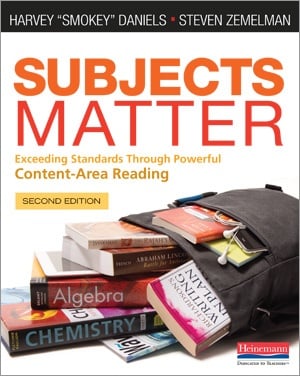In Part 1 of our Q&A with Smokey (@SmokeyLit) and Steve (@StevenZemelman), they talked about content-area reading. Today, they talk about collaboration among teachers to help implement the lesson and share a little about their fundamental beliefs and practices.
In Part 1 of our Q&A with Smokey (@SmokeyLit) and Steve (@StevenZemelman), they talked about content-area reading. Today, they talk about collaboration among teachers to help implement the lesson and share a little about their fundamental beliefs and practices.
Question 4: You guys write a lot about students learning through collaboration. Can teachers also take the idea of collaboration into their own professional learning?
Smokey: Collaboration is the watchword for the most effective staff development models we have encountered. If you come to one of our teacher workshops, be prepared to work with partners and teams all day long! Where we have seen struggling schools really grow, change, and raise student achievement, it is virtually always driven by the teachers working together with each other in sustained and focused ways. It all begins with an atmosphere of friendliness and support, which can be cultivated when teachers meet in one another’s classrooms, plan lessons together, join in ongoing reading groups, or do voluntary demonstration lessons for colleagues to view. Sadly, we often see potentially collaborative professional development structures undermined—as when professional learning communities (PLCs) are co-opted into the endless analysis of test score spreadsheets. Neither teachers nor students are data, and both grow best through human interaction in a collaborative community.
Question 5: In many schools, teachers feel powerless in the face of more than a decade of external mandates. Steve, drawing from research and experiences you shared in 13 Steps to Teacher Empowerment, what are some steps teachers can take to reclaim their professional role?
Steve: Let me try to answer this by connecting teacher leadership with our main topic here, reading in content areas. New standards assert that we must support reading in our subjects—and this is surely necessary. But we are the ones who know our kids and our subjects. We know that if students are to develop mandated skills, they need not just to be told about them, or given practice drills about them. As we’ve described in Subjects Matter, Second Edition, young people need to be immersed in thinking about the ideas in the material, and in connecting those ideas with their own lives—even if the standards never emphasize this. We can of course work on this alone, in our own classrooms. But it’s so much more effective to share ideas with colleagues, and we can even gain support from administrators. One key strategy for starting this that I’ve learned from community organizers and described in 13 Steps, is the one-on-one sit-down with colleagues. This enables each person in the discussion to learn the background and values of the other, and to see where they share interests in common. This may start small, but it can lay the groundwork for larger efforts that enable teachers as a group to have more influence and gain positive recognition. A great example is the ongoing work to support reading in all subject areas in the two Downers Grove high schools, in Chicago’s suburbs. As a result of extensive effort, teachers in all subject areas in the schools participate in a multiyear cycle of professional development and share the strategies they use. We featured their efforts in our new edition of Subjects Matter, and the schools were just featured in a glowing news story in the Chicago Tribune.
Question 6: The two of you have written seven books and videos together with Heinemann over many years. Has a particular belief remained steadfast? Have they evolved in some ways?
Steve: Actually, we think that all the Heinemann authors share some essential beliefs. We all assert the importance of knowing our students, learning who they are, looking and listening closely, recognizing how much they are capable of, and building on their abilities. We all recognize the importance of creating engagement in the classroom, immersing students in issues that matter, and making school relevant to their lives. We all work to help teachers do these things, learn from and celebrate them, and continue on this path in spite of the many pressures they face. What has evolved is that great teachers have created many more tools and strategies since we began, and the rest of us have had the benefit of borrowing them and learning from them. I can recall that when I first started teaching and writing about this work, none of us had even heard of writers’ workshop, if you can believe that. No doubt some teachers were already using it, but no one had written or talked about it. And having and sharing such tools has enabled us to help many students advance much further than we might have even imagined, and many teachers feel much more successful in their work. Now if only the wider public and policy-makers understood this….
Question 7: Schools are using a lot of technology and many are moving towards one-on-one environments. How does this impact the big public-writing projects you encourage in schools? Does it have an impact on your student reflections?
Smokey: We are big fans of one-to-one technology because it really encourages students becoming researchers. We also work in enough schools around the country to know that not all kids and teachers enjoy this advantage yet. We think that access to one-to-one technology is becoming a civil rights issue; if some kids don’t have the customary tools of contemporary life to learn with, how can we say they are getting an even chance? New technologies can potentiate learning, but you must use the right tool for the job. Think of a smart board: a costly, teacher-controlled device that sits in front of the classroom, where students still mostly watch it, and much of the proffered software is the digital equivalent of worksheets. Now consider putting a web-enabled tablet or laptop in every kid’s hands; that’s transformational. Used to its potential, one-to-one technology offers kids differentiated opportunities, choices, and responsibility for their own learning, record keeping, connection and sharing. So for those big inquiry projects we recommend in Subjects Matter, Second Edition, ready access to just-right technology helps kids to work faster and smarter, both together and alone. But remember, you can still do sensational research projects using books, surveys, interviews, observations, and other information gathering tools that don’t require a single byte of ram.



